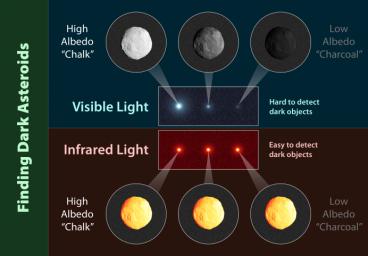
|
Infrared Telescopes Spy Small, Dark Asteroids
- Click the image above for a larger view
- Full-Res JPEG (3450 x 2400) (457.8 kB)
- Full-Res TIFF (3450 x 2400) (24.8 MB)
Caption:
This chart illustrates why infrared-sensing telescopes are more suited to finding small, dark asteroids than telescopes that detect visible light. The top of the chart shows how three asteroids of the same size but differing compositions would appear in visible light. An asteroid that has a shinier surface, or higher albedo, will appear brighter than a dark asteroid, even though they are the same size. This is because a shinier asteroid will reflect more visible light from the sun.
The bottom of the chart shows the same three asteroids when viewed in infrared light. They appear to be the same brightness, regardless of their albedo. Objects of the same size will radiate about the same amount of infrared light, as result of being heated by the sun. It's easier for an infrared telescope to see a small, dark asteroid because it senses the object's heat signature and not the little amounts of reflected sunlight.
Background Info:
JPL manages the Wide-field Infrared Survey Explorer for NASA's Science Mission Directorate, Washington. The principal investigator, Edward Wright, is at UCLA. The mission was competitively selected under NASA's Explorers Program managed by the Goddard Space Flight Center, Greenbelt, Md. The science instrument was built by the Space Dynamics Laboratory, Logan, Utah, and the spacecraft was built by Ball Aerospace & Technologies Corp., Boulder, Colo. Science operations and data processing take place at the Infrared Processing and Analysis Center at the California Institute of Technology in Pasadena. Caltech manages JPL for NASA.
More information is online at http://www.nasa.gov/wise and http://wise.astro.ucla.edu .
Cataloging Keywords:
| Name | Value | Additional Values |
|---|---|---|
| Target | 4 Vesta | |
| System | Main Belt | |
| Target Type | Asteroid | |
| Mission | Near-Earth Object Wide-field Infrared Survey Explorer (NEOWISE) | |
| Instrument Host | NEOWISE | |
| Host Type | Space Telescope | |
| Instrument | NEOWISE Telescope | |
| Detector | ||
| Extra Keywords | Color, Infrared | |
| Acquisition Date | ||
| Release Date | 2011-09-29 | |
| Date in Caption | ||
| Image Credit | NASA/JPL-Caltech | |
| Source | photojournal.jpl.nasa.gov/catalog/PIA14732 | |
| Identifier | PIA14732 | |
